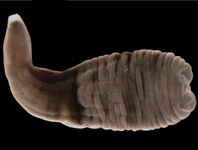Abstract
Crangonyx ephemerus n. sp. and Crangonyx pseudoephemerus n. sp. are described from the headwaters of the St. Marks River in Leon County, Florida, based on detailed morphological and molecular comparisons with the closely related species Crangonyx floridanus Bousfield, 1963. The morphological and molecular data, including three species delimitation models, lend support to the hypothesis that the taxon C. floridanus sensu lato represents a species complex. Diagnostic morphological characteristics are highlighted and discussed within this group to assist in future morphological analyses.
References
Abràmoff, M.D., Magalhães, P.J. & Ram, S.J. (2004) Image processing with ImageJ. Biophotonics International, 11 (7), 36–42.
Bousfield, E.L. (1963) New freshwater amphipod crustaceans from Florida, Natural History Papers. National Museum of Canada, 18, 1–9.
Bousfield, E.L. (1958) Shallow-water gammaridean Amphipoda of New England. Cornell University Press, New York, 312 pp.
Borutzky, E.W. (1928) Materialien über die Fauna der unterirdischen Gewässer: Crangonyx chlebnikovi sp. n. (Amphipoda) aus den Höhlen des mittleren Urals. Zoologischer Anzeiger, 77, 253–259.
Cannizzaro, A.G., Balding, D., Lazo-Wasem, E.A. & Sawicki, T.R. (2019a) Morphological and molecular analyses reveal a new species of stygobitic amphipod in the genus Crangonyx (Crustacea: Crangonyctidae) from Jackson County, Florida, with a redescription of Crangonyx floridanus and notes on its taxonomy and biogeography. Journal of Natural History, 53 (7–8), 425–473.
Cannizzaro, A.G., Balding, D., Lazo-Wasem, E.A. & Sawicki, T.R. (2019b) A redescription of Hobb’s cave amphipod Crangonyx hobbsi Shoemaker, 1941 (Amphipoda: Senticaudata: Crangonyctidae) including genetic sequence data for mitochondrial and nuclear genes and notes on its ecology. Proceedings of the Biological Society of Washington, 132 (1), 73–95
Crandall, K.A. & Buhay, J.E. (2007) Global diversity of crayfish (Astacidae, Cambaridae, and Parastacidae—Decapoda) in freshwater. In: Balian, E.V., Leveque, C., Segers, H. & Marten, K. (Eds.), Freshwater Animal Diversity Assessment. Springer, Dordrecht, pp. 295–301.
Drummond, A.J., Ashton, B., Buxton, S., Cheung, M. & Cooper, A. (2017) Geneious. Version 10.2.3. Available from: http://www.geneious.com/ (accessed 30 May 2017)
Englisch, U. & Koenemann, S. (2001) Preliminary phylogenetic analysis of selected subterranean amphipod crustaceans, using small subunit rDNA gene sequences. Organisms Diversity & Evolution, 1 (2), 139–145.
https://doi.org/10.1078/1439-6092-00011
Fišer, C.E., Sket, B. & Trontelj, P. (2008) A phylogenetic perspective on 160 years of troubled taxonomy of Niphargus (Crustacea: Amphipoda). Zoologica Scripta, 37 (6), 665–680.
https://doi.org/10.1111/j.1463-6409.2008.00347.x
Flot, J.F., Wörheide, G. & Dattagupta, S. (2010) Unsuspected diversity of Niphargus amphipods in the chemoautotrophic cave ecosystem of Frasassi, central Italy. BMC Evolutionary Biology, 10 (1), 171.
https://doi.org/10.1186/1471-2148-10-171
Folmer, O., Black, M., Hoeh, W., Lutz, R. & Vrijenhoek, R. (1994) DNA primers for amplification of mitochondrial cytochrome c oxidase subunit I from diverse metazoan invertebrates. Molecular Marine Biology and Biotechnology, 3 (5), 294–299.
Hammer, Ø., Harper, D.A.T. & Ryan, P.D. (2001) PAST: Paleontological statistics software package for education and data analysis. Paleontologica Electronica, 4 (1), 1–9.
Hou, Z., Fu, J. & Li, S. (2007) A molecular phylogeny of the genus Gammarus (Crustacea: Amphipoda) based on mitochondrial and nuclear gene sequences. Molecular Phylogenetics and Evolution, 45 (2), 596–611.
https://doi.org/10.1016/j.ympev.2007.06.006
Katoh, K. & Standley, D.M. (2013) MAAFT multiple sequence alignment software version 7: improvements in performance and usability. Molecular biology and evolution, 30 (4), 772–780.
https://doi.org/10.1093/molbev/mst010
Kristjánsson, B.K. & Svavarsson, J. (2004) Crymostygidae, a new family of subterranean freshwater gammaridean amphipods (Crustacea) recorded from subarctic Europe. Journal of Natural History, 38 (15), 1881–1894.
https://doi.org/10.1080/00222930310001597295
Lanfear, R., Calcott, N. & Ho, S.Y. (2012) PartitionFinder: combined selection of partitioning schemes and substitution models for phylogenetic analyses. Molecular Biology and Evolution, 29 (6), 1695–1701.
https://doi.org/10.1093/molbev/mss020
Lanfear, R., Fradsen, P.B. & Wright, A.M. (2016) PartitionFinder 2: new methods for selected partitioned models of evolution for molecular and morphological phylogenetic analyses. Molecular Biology and Evolution, 34 (3), 772–773.
https://doi.org/10.1093/molbev/msw260
Neves, R.K., Bogan, A.E., Williams, J. D., Ahlstedt, S.A. & Hartfield, P.D. (1998) Status of aquatic mollusks in the southeastern United States: a downward spiral of diversity. In: Benz, G. W. & Collins, D.E. (Eds.), Aquatic Fauna in Peril: The Southeastern Perspective. Special Publication No. 1. Southeastern Aquatic Research Institute, Decatur, Georgia, pp. 43–86.
Palumbi, S., Martin, A., Romano, S. & McMillan, W.O. (1991) The Simple Fool’s Guide to PCR, Version 2.0. University of Hawaii, Hawaii, 43 pp.
Ronquist, F. & Huelsenbeck, J.P. (2003) MRBAYES 3: Bayesian phylogenetic inference under mixed models. Bioinformatics, 19 (12), 1572–1574.
https://doi.org/10.1093/bioinformatics/btg180
Saiki, R., Gelfland, D.H., Stofell, S., Scharf, S.J., Higuchi, R., Horn, G.T., Mullis, B. & Elrich, H.A. (1988) Primer directed enzymatic amplification of DNA with a thermostable DNA polymerase. Science, 239 (4839), 487–491.
Seidel, R.A., Lang, B.K. & Berg, D.J. (2009) Phylogeographic analysis reveals multiple cryptic species of amphipods (Crustacea: Amphipoda) in Chihuahuan Desert springs. Biological Conservation, 142 (10), 2303–2313.
https://doi.org/10.1016/j.biocon.2009.05.003
Svavarsson, J. & Kristjánsson, B.K. (2006) Crangonyx islandicus sp. nov., a subterranean freshwater amphipod (Crustacea, Amphipoda, Crangonyctidae) from springs in lava fields in Iceland. Zootaxa, 1365 (1), 1–17.
Väinölä, R., Witt, J.D.S., Grabowski, M., Bradbury, J.H., Jazdzewski, K. & Sket, B. (2007) Global diversity of amphipods (Amphipoda: Crustacea) in freshwater. In: Balian, E.V., Leveque, C., Segers, H. & Marten, K, (Eds.), Freshwater Animal Diversity Assessment. Springer, Dordrecht, pp. 241–255.
White, K.N. (2011) Nuclear 18S rDNA as a species-level molecular marker for Leucothoidae (Amphipoda). Journal of Crustacean Biology, 31 (4), 710–716.
https://doi.org/10.1651/11-3489.1
Zhang J. & Holsinger J.R. (2003) Systematics of the freshwater amphipod genus Crangonyx (Crangonyctidae) in North America. Virginia Museum of Natural History, Virginia, 274 pp.

